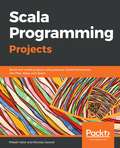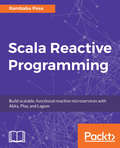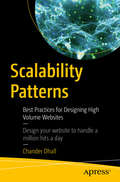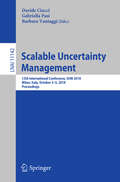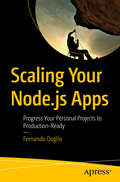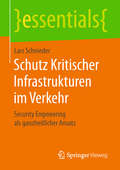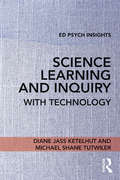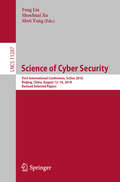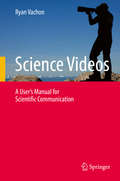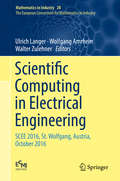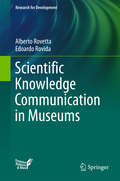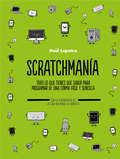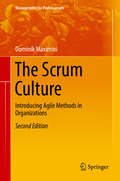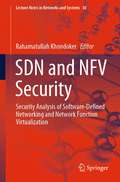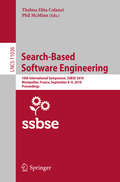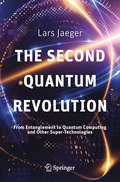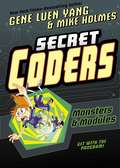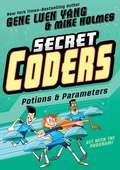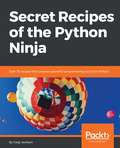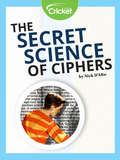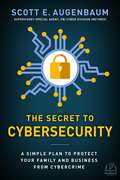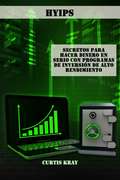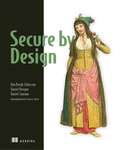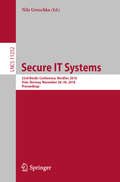- Table View
- List View
Scala Programming Projects: Build real world projects using popular Scala frameworks like Play, Akka, and Spark
by Mikaël Valot Nicolas JorandDiscover unique features and powerful capabilities of Scala Programming as you build projects in a wide range of domainsKey FeaturesDevelop a range of Scala projects from web applications to big data analysisLeverage full power of modern web programming using Play FrameworkBuild real-time data pipelines in Scala with a Bitcoin transaction analysis appBook DescriptionScala is a type-safe JVM language that incorporates object-oriented and functional programming (OOP and FP) aspects. This book gets you started with essentials of software development by guiding you through various aspects of Scala programming, helping you bridge the gap between learning and implementing. You will learn about the unique features of Scala through diverse applications and experience simple yet powerful approaches for software development.Scala Programming Projects will help you build a number of applications, beginning with simple projects, such as a financial independence calculator, and advancing to other projects, such as a shopping application and a Bitcoin transaction analyzer. You will be able to use various Scala features, such as its OOP and FP capabilities, and learn how to write concise, reactive, and concurrent applications in a type-safe manner. You will also learn how to use top-notch libraries such as Akka and Play and integrate Scala apps with Kafka, Spark, and Zeppelin, along with deploying applications on a cloud platform.By the end of the book, you will not only know the ins and outs of Scala, but you will also be able to apply it to solve a variety of real-world problemsWhat you will learnBuild, test, and package code using Scala Build ToolDecompose code into functions, classes, and packages for maintainabilityImplement the functional programming capabilities of ScalaDevelop a simple CRUD REST API using the Play frameworkAccess a relational database using SlickDevelop a dynamic web UI using Scala.jsSource streaming data using Spark Streaming and write a Kafka producerUse Spark and Zeppelin to analyze dataWho this book is forIf you are an amateur programmer who wishes to learn how to use Scala, this book is for you. Knowledge of Java will be beneficial, but not necessary, to understand the concepts covered in this book.
Scala Reactive Programming: Build scalable, functional reactive microservices with Akka, Play, and Lagom
by Rambabu PosaBuild fault-tolerant, robust, and distributed applications in Scala Key Features - Understand and use the concepts of reactive programming to build distributed systems running on multiple nodes. - Learn how reactive architecture reduces complexity throughout the development process. - Get to grips with functional reactive programming and Reactive Microservices. Book Description Reactive programming is a scalable, fast way to build applications, and one that helps us write code that is concise, clear, and readable. It can be used for many purposes such as GUIs, robotics, music, and others, and is central to many concurrent systems. This book will be your guide to getting started with Reactive programming in Scala. You will begin with the fundamental concepts of Reactive programming and gradually move on to working with asynchronous data streams. You will then start building an application using Akka Actors and extend it using the Play framework. You will also learn about reactive stream specifications, event sourcing techniques, and different methods to integrate Akka Streams into the Play Framework. This book will also take you one step forward by showing you the advantages of the Lagom framework while working with reactive microservices. You will also learn to scale applications using multi-node clusters and test, secure, and deploy your microservices to the cloud. By the end of the book, you will have gained the knowledge to build robust and distributed systems with Scala and Akka. What you will learn Understand the fundamental principles of Reactive and Functional programming Develop applications utilizing features of the Akka framework Explore techniques to integrate Scala, Akka, and Play together Learn about Reactive Streams with real-time use cases Develop Reactive Web Applications with Play, Scala, Akka, and Akka Streams Develop and deploy Reactive microservices using the Lagom framework and ConductR Who this book is for This book is for Scala developers who would like to build fault-tolerant, scalable distributed systems. No knowledge of Reactive programming is required.
Scalability Patterns: Best Practices for Designing High Volume Websites
by Chander DhallIn this book, the CEO of Cazton, Inc. and internationally-acclaimed speaker, Chander Dhall, demonstrates current website design scalability patterns and takes a pragmatic approach to explaining their pros and cons to show you how to select the appropriate pattern for your site. He then tests the patterns by deliberately forcing them to fail and exposing potential flaws before discussing how to design the optimal pattern to match your scale requirements. The author explains the use of polyglot programming and how to match the right patterns to your business needs. He also details several No-SQL patterns and explains the fundamentals of different paradigms of No-SQL by showing complementary strategies of using them along with relational databases to achieve the best results. He also teaches how to make the scalability pattern work with a real-world microservices pattern. With the proliferation of countless electronic devices and the ever growing number of Internet users, the scalability of websites has become an increasingly important challenge. Scalability, even though highly coveted, may not be so easy to achieve. Think that you can't attain responsiveness along with scalability? Chander Dhall will demonstrate that, in fact, they go hand in hand.What You'll LearnArchitect and develop applications so that they are easy to scale. Learn different scaling and partitioning options and the combinations. Learn techniques to speed up responsiveness. Deep dive into caching, column-family databases, document databases, search engines and RDBMS. Learn scalability and responsiveness concepts that are usually ignored.Effectively balance scalability, performance, responsiveness, and availability while minimizing downtime.Who This Book Is ForExecutives (CXOs), software architects , developers, and IT Pros
Scalable Uncertainty Management: 12th International Conference, SUM 2018, Milan, Italy, October 3-5, 2018, Proceedings (Lecture Notes in Computer Science #11142)
by Davide Ciucci Gabriella Pasi Barbara VantaggiThis book constitutes the refereed proceedings of the 12th International Conference on Scalable Uncertainty Management, SUM 2018, which was held in Milan, Italy, in October 2018. The 23 full, 6 short papers and 2 tutorials presented in this volume were carefully reviewed and selected from 37 submissions. The conference is dedicated to the management of large amounts of complex, uncertain, incomplete, or inconsistent information. New approaches have been developed on imprecise probabilities, fuzzy set theory, rough set theory, ordinal uncertainty representations, or even purely qualitative models.
Scaling Your Node.js Apps: Progress Your Personal Projects to Production-Ready
by Fernando DoglioTake your Node.js application into production-ready status, capable of scaling up to whatever your needs might be. You'll discover that architecting for successful, popular sites is an essential tool of any professional Node.js developer, and learning to scale your own applications is a great place to start. Using this book you will learn when to scale, what factors should trigger scaling, and what architectural techniques are best suited for scaling. You will also explore common pitfalls that arise when scaling a Node.js application and solutions to correct them.Including analyses of success cases at the largest-scale companies, such as Netflix and Paypal, this book will get you started with scaling in no time at all. What You'll LearnDetermine what factors should trigger the need to scaleDiscover different architectural patterns that lend themselves to scalingResolve problems that arise when scaling up a Node.js applicationMonitor a platform in order to understand when to start scalingWho This Book Is ForThe main audience for this book are Node.js developers with a mid-level understanding of the technology. Novice Node users will also benefit from the coverage of generic scaling-related topics.
Schutz Kritischer Infrastrukturen im Verkehr: Security Engineering als ganzheitlicher Ansatz (essentials)
by Lars SchniederVerkehrsinfrastrukturen sind ein Rückgrat unserer Gesellschaft. Dieses essential beantwortet die Frage, was unter einer Kritischen Verkehrsinfrastruktur zu verstehen ist. IT-Systeme sind für die effektive Steuerung Kritischer Verkehrsinfrastrukturen elementar. Deshalb sind diese besonders gegen unberechtigte Zugriffe von außen zu schützen. Die Motivation zur Absicherung Kritischer Verkehrsinfrastrukturen wird aus geltenden rechtlichen Sicherheitspflichten heraus begründet. In Anlehnung an den in der Praxis seit Langem bewährten europäischen Rechtsrahmen der Produktsicherheit werden die einzelnen aufeinander bezogenen Glieder einer Qualitätssicherungskette für die Absicherung der IT-Sicherheit Kritischer Verkehrsinfrastrukturen dargestellt. Mit dem Gestaltungsparadigma der tiefgestaffelten Verteidigung (defense in depth) werden konkrete Handlungsoptionen für die organisatorische und systemtechnische Ausgestaltung des Schutzes Kritischer Verkehrsinfrastrukturen aufgezeigt.Der AutorDr.-Ing. Lars Schnieder verantwortet in einer Software-Entwicklungsfirma das Geschäftsfeld Sicherheitsbegutachtung. Er ist international als anerkannter Sachverständiger für Zugsicherungsanlagen tätig.
Science Learning and Inquiry with Technology (Ed Psych Insights)
by Diane Jass Ketelhut Michael Shane TutwilerWhen implemented effectively, technology has great potential to positively connect with learning, assessment, and motivation in the context of K–12 science education and inquiry. Written by leading experts on technology-enhanced science learning and educational research, this book situates the topic within the broader context of educational psychology research and theory and brings it to a wider audience. With chapters on the fundamentals of science learning and assessment, integration of technology into classrooms, and examples of specific technologies, this concise volume is designed for any course on science learning that includes technology use in the curriculum. It will be indispensable for student researchers and both pre- and in-service teachers alike.
Science of Cyber Security: First International Conference, SciSec 2018, Beijing, China, August 12-14, 2018, Revised Selected Papers (Lecture Notes in Computer Science #11287)
by Feng Liu Shouhuai Xu Moti YungThis book constitutes the proceedings of the First International Conference on Science of Cyber Security, SciSec 2018, held in Beijing, China, in August 2018.The 11 full papers and 6 short papers presented in this volume were carefully reviewed and selected from 54 submissions. The papers focus on science of security; cybersecurity dynamics; attacks and defenses; network security; security metrics and measurements; and performance enhancements.
Science Videos: A User's Manual For Scientific Communication
by Ryan VachonEffective science communication is no easy task. While the effective conveyance of technical knowledge presents formidable roadblocks to sharing scientific knowledge and discoveries, certain communication tools like video and film production help to bridge this gap. This user’s manual provides a complete set of easy-to-follow directions for video-making as well as tricks of the trade to leverage these skills to better inform the intended audience.
Scientific Computing in Electrical Engineering: Scee 2016, St. Wolfgang, Austria, October 2016 (Mathematics In Industry Ser. #28)
by Ulrich Langer Wolfgang Amrhein Walter ZulehnerThis collection of selected papers presented at the 11th International Conference on Scientific Computing in Electrical Engineering (SCEE), held in St. Wolfgang, Austria, in 2016, showcases the state of the art in SCEE. The aim of the SCEE 2016 conference was to bring together scientists from academia and industry, mathematicians, electrical engineers, computer scientists, and physicists, and to promote intensive discussions on industrially relevant mathematical problems, with an emphasis on the modeling and numerical simulation of electronic circuits and devices, electromagnetic fields, and coupled problems. The focus in methodology was on model order reduction and uncertainty quantification. This extensive reference work is divided into six parts: Computational Electromagnetics, Circuit and Device Modeling and Simulation, Coupled Problems and Multi‐Scale Approaches in Space and Time, Mathematical and Computational Methods Including Uncertainty Quantification, Model Order Reduction, and Industrial Applications. Each part starts with a general introduction, followed by the respective contributions. This book will appeal to mathematicians and electrical engineers. Further, it introduces algorithm and program developers to recent advances in the other fields, while industry experts will be introduced to new programming tools and mathematical methods.
Scientific Knowledge Communication in Museums (Research For Development Ser.)
by Alberto Rovetta Edoardo RovidaThis book explains the general principles of scientific and technical communication in the context of modern museums. It also examines, with the aid of informative case studies, the different means by which knowledge can be transmitted, including posters, objects, explanatory guidance, documentation, and catalogues. Highlighting the ever more important role of multimedia and virtual reality components in communicating understanding of and facilitating interaction with the displayed object, it explores how network communications systems and algorithms can be applied to offer individual users the information that is most pertinent to them. The book is supported by a Dynamic Museums app connected to museum databases where series of objects can be viewed via cloud computing and the Internet and printed using 3D printing technology. This book is of interest to a diverse readership, including all those who are responsible for museums’ collections, operations, and communications as well as those delivering or participating in courses on museums and their use, communication design and related topics.
Scratchmanía
by Raúl Lapeira¡Scratch, la programación al alcance de los más pequeños, de la mano de los máximos expertos en España! Scratch es el lenguaje de programación visual más sencillo con el que los niños podrán dar sus primeros pasos sin tener un conocimiento profundo de código. El libro combina la teoría y explicación sobre lo que es el scratch, a la vez que plantea proyectos sencillos para llevar a cabo utilizando la herramienta que se ha estudiado en un comienzo.
The Scrum Culture: Introducing Agile Methods In Organizations (Management For Professionals)
by Dominik MaximiniThis book is a guide for managers, Scrum Masters and agile coaches who are interested in agile organizational methods and who are planning to introduce Scrum at their own company. Scrum is not only a product development framework but can also be used to structure activities for agile and lean organizational development.Divided into six major parts, the book first introduces and defines the Scrum Culture briefly. It explains its relevance, highlights a number of pain points typical for first encounters with Scrum, and embeds it in an introduction to organizational change. This is complemented with many real-life examples that help to apply the concepts to readers’ own specific contexts. The second part describes the principles of introducing Scrum in detail, while the third part embarks on the practical application of these principles, drawing on a wealth of experience gathered in many successful introduction projects. Part four focuses on a detailed case study of a Scrum transformation before part five provides the scientific background information and study details that led to the findings in part one. In closing, part six offers a number of appendices with extensive information on Scrum and its principles.The second edition of this book has been updated throughout and fundamentally re-organized for better readability.
SDN and NFV Security: Security Analysis of Software-Defined Networking and Network Function Virtualization (Lecture Notes in Networks and Systems #30)
by Rahamatullah KhondokerThis book provides security analyses of several Software Defined Networking (SDN) and Network Functions Virtualization (NFV) applications using Microsoft's threat modeling framework STRIDE. Before deploying new technologies in the production environment, their security aspects must be considered. Software Defined Networking (SDN) and Network Functions Virtualization (NFV) are two new technologies used to increase e. g. the manageability, security and flexibility of enterprise/production/cloud IT environments. Also featuring a wealth of diagrams to help illustrate the concepts discussed, the book is ideally suited as a guide for all IT security professionals, engineers, and researchers who need IT security recommendations on deploying SDN and NFV technologies.
Search-Based Software Engineering: 10th International Symposium, SSBSE 2018, Montpellier, France, September 8-9, 2018, Proceedings (Lecture Notes in Computer Science #11036)
by Thelma Elita Colanzi Phil McMinnThis book constitutes the refereed proceedings of the 10th International Symposium on Search-Based Software Engineering, SSBSE 2018, held in Montpellier, France, in September 2018. The 12 full papers and 7 short papers presented together with 3 keynotes, 2 tutorials, and 1 anniversary paper were carefully reviewed and selected from 21 submissions. SSBSE welcomes not only applications from throughout the software engineering lifecycle but also a broad range of search methods ranging from exact Operational Research techniques to nature-inspired algorithms and simulated annealing.Chapter "Deploying Search Based Software Engineering with Sapienz at Facebook" is available open access under a Creative Commons Attribution 4.0 International License via link.springer.com.
Second Handbook of Information Technology in Primary and Secondary Education
by Joke Voogt Gerald Knezek Rhonda Christensen Kwok-Wing LaiIn this second edition the editors continue their efforts to synthesize research and practice and project future directions in the field of information and communication technology. The proliferation of mobile devices and applications have had major implications on how the nature of teaching and learning should be conceptualised, and what pedagogical practices should be used to support bridging formal and informal learning. The advent of social media also highlights the importance of gaining a deeper understanding of social learning theories and computer-supported collaborative learning theories and practices. The advancement of new technologies to support easy accessibility of educational resources such as OER and to a lesser extent MOOCs have led to the debate on how assessment should be conducted and how technologies could be used to support it. The demand of the knowledge society requires that researchers, policy makers, and educational practitioners be conversant with new research findings in order to understand the impact of ICT in teaching and learning, and how to support learners to use new technologies and applications creatively and effectively. New research paradigms have emerged to meet these challenges.
The Second Quantum Revolution: From Entanglement to Quantum Computing and Other Super-Technologies
by Lars JaegerThis book tells the story of the second quantum revolution which will shape the 21st century as much as the first quantum revolution shaped the 20th century. It provides unique orientation in today's discussion and the latest progress on the interpretation of quantum physics and its further technological potential. As you read this book the first prototypes of this revolution are being built in laboratories worldwide. Super-technologies such as nanotechnology, quantum computers, quantum information processing, and others will soon shape our daily lives, even if physicists themselves continue to disagree on how to interpret the central theory of modern physics. The book will thus also touch on the profound philosophical questions at the heart of quantum mechanics.
Secret Coders: Monsters & Modules (Secret Coders #6)
by Gene Luen YangFrom graphic novel superstar (and former computer programming teacher) and New York Times bestselling author Gene Luen Yang, Secret Coders: Monsters & Modules is the sixth and final volume in a wildly entertaining series that combines logic puzzles and basic coding instruction with a page-turning mystery plot!The Coders always knew their programming skills would take them far, but they never guessed they would take them to another dimension! Or to be accurate, one dimension less—to save humanity, Hopper, Eni, and Josh must travel to Flatland, a dangerous two-dimensional world ruled by polygons. If they can return home safely with a turtle of light, they might just stand a chance in their final showdown with Dr. One-Zero!
Secret Coders: Potions & Parameters (Secret Coders #5)
by Gene Luen YangFrom graphic novel superstar (and former computer programming teacher) and New York Times bestselling author Gene Luen Yang, Secret Coders: Potions & Parameters is the fifth volume in a wildly entertaining series that combines logic puzzles and basic coding instruction with a page-turning mystery plot!Dr. One-Zero won't stop until the whole town—no, the whole world—embraces the "true happiness” found in his poisonous potion, Green Pop. And now that he has the Turtle of Light, he’s virtually unstoppable.There's one weapon that can defeat him: another Turtle of Light. Unfortunately, they can only be found in another dimension! To open a portal to this new world, Hopper, Eni, and Josh's coding skills will be put to the test.
Secret Recipes of the Python Ninja: Over 70 recipes that uncover powerful programming tactics in Python
by Cody JacksonTest your Python programming skills by solving real-world problemsKey FeaturesAccess built-in documentation tools and improve your code.Discover how to make the best use of decorator and generator functionsEnhance speed and improve concurrency by conjuring tricks from the PyPy projectBook DescriptionThis book covers the unexplored secrets of Python, delve into its depths, and uncover its mysteries.You’ll unearth secrets related to the implementation of the standard library, by looking at how modules actually work. You’ll understand the implementation of collections, decimals, and fraction modules. If you haven’t used decorators, coroutines, and generator functions much before, as you make your way through the recipes, you’ll learn what you’ve been missing out on. We’ll cover internal special methods in detail, so you understand what they are and how they can be used to improve the engineering decisions you make. Next, you’ll explore the CPython interpreter, which is a treasure trove of secret hacks that not many programmers are aware of. We’ll take you through the depths of the PyPy project, where you’ll come across several exciting ways that you can improve speed and concurrency. Finally, we’ll take time to explore the PEPs of the latest versions to discover some interesting hacks.What you will learnKnow the differences between .py and .pyc files Explore the different ways to install and upgrade Python packagesUnderstand the working of the PyPI module that enhances built-in decoratorsSee how coroutines are different from generators and how they can simulate multithreadingGrasp how the decimal module improves floating point numbers and their operationsStandardize sub interpreters to improve concurrencyDiscover Python’s built-in docstring analyzerWho this book is forWhether you’ve been working with Python for a few years or you’re a seasoned programmer, you’ll have a lot of new tricks to walk away with.
The Secret Science of Ciphers
by Nick D'AltoEven if you aren't a spy, you probably already use cryptography, or the science of secret communication, every day.
The Secret to Cybersecurity: A Simple Plan to Protect Your Family and Business from Cybercrime
by Scott AugenbaumCybercrimes are a threat and as dangerous as an armed intruder—yet millions of Americans are complacent or simply uninformed of how to protect themselves. The Secret to Cybersecurity closes that knowledge gap by using real-life examples to educate readers.It’s 2 a.m.—do you know who your child is online with? According to author Scott Augenbaum, between 80 to 90 percent of students say they do whatever they want on their smartphones—and their parents don’t have a clue. Is that you? What about your online banking passwords, are they safe? Has your email account or bank/debit card ever been compromised? In 2018, there were data breaches at several major companies—If those companies have your credit or debit information, that affects you. There are bad people in the world, and they are on the internet. They want to hurt you. They are based all over the world, so they’re hard at “work” when even you’re sleeping. They use automated programs to probe for weaknesses in your internet security programs. And they never stop. Cybercrime is on the increase internationally, and it’s up to you to protect yourself. But how? The Secret to Cybersecurity is the simple and straightforward plan to keep you, your family, and your business safe. Written by Scott Augenbaum, a 29-year veteran of the FBI who specialized in cybercrimes, it uses real-life examples to educate and inform readers, explaining who/why/how so you’ll have a specific takeaway to put into action for your family. Learn about the scams, methods, and ways that cyber criminals operate—and learn how to avoid being the next cyber victim.
Secretos para Hacer Dinero en Serio con Programas de Inversión de Alto Rendimiento (HYIPS)
by Curtis KrayDecidí escribir este libro para poder ayudar a todas esas decenas de miles de pequeños inversionistas que se han integrado a Programas de Inversión de Alto Rendimiento (HYIPs) cada año con la esperanza de hacer dinero suficiente para vivir y que, invariablemente han terminado seriamente devastados. Estoy convencido de que la mayoría de la gente que pierde dinero al invertir en HYIPs, carece de la información fundamental sobre su funcionamiento, sobre quienes integran éste juego, y sobre cuál es su verdadera motivación. Para que todos los procesos intelectuales, actitudes y trampas que se tienen que enfrentar puedan entenderse fácilmente es que he escrito este libro. Con la información que se incluye en él, se podrán aprovechar desde distintos ángulos, ingeniosas oportunidades que pondrán en ventaja al inversionista para generar grandes cantidades de dinero.
Secure by Design
by Daniel Sawano Dan Bergh Johnsson Daniel DeogunAs a developer, you need to build software in a secure way. But you can't spend all your time focusing on security. The answer is to use good design principles, tools, and mindsets that make security an implicit result - it's secure by design. Secure by Design teaches developers how to use design to drive security in software development. This book is full of patterns, best practices, and mindsets that you can directly apply to your real world development. Purchase of the print book includes a free eBook in PDF, Kindle, and ePub formats from Manning Publications.
Secure IT Systems: 23rd Nordic Conference, NordSec 2018, Oslo, Norway, November 28-30, 2018, Proceedings (Lecture Notes in Computer Science #11252)
by Nils GruschkaThis book constitutes the refereed proceedings on the 23rd Nordic Conference on Secure IT Systems, NordSec 2018, held in Oslo, Norway, in November 2018.The 29 full papers presented in this volume were carefully reviewed and selected from 81 submissions. They are organized in topical sections named: privacy; cryptography; network and cloud security; cyber security and malware; and security for software and software development.
